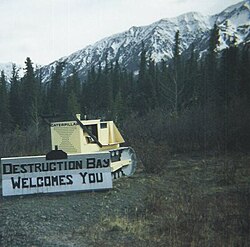Destruction Bay
This article includes a list of general references, but it lacks sufficient corresponding inline citations. (July 2015) |
Destruction Bay | |
|---|---|
 Welcome sign made on an old bulldozer | |
 Destruction Bay | |
| Coordinates: 61°15′15″N 138°48′24″W / 61.25417°N 138.80667°WCoordinates: 61°15′15″N 138°48′24″W / 61.25417°N 138.80667°W | |
| Country | Canada |
| Territory | Yukon |
| Area | |
| • Land | 13.57 km2 (5.24 sq mi) |
| Population (2016)[1] | |
| • Total | 55 |
| • Density | 4.1/km2 (11/sq mi) |
| Time zone | UTC−07:00 (MST) |
Destruction Bay is a small community on the Alaska Highway (historical mile 1083) in Canada's Yukon on Kluane Lake.
Populated mostly by non-aboriginal residents, community residents provide Yukon government services to residents in the area (school, highway maintenance), including nearby Burwash Landing and some tourism-related businesses along the Alaska Highway. The name is derived from the wind blowing down structures erected by the military during highway construction in 1942–43.
The community has a one-room school serving kindergarten through grade eight.
Demographics[]
In the 2021 Census of Population conducted by Statistics Canada, Destruction Bay recorded a population of 40 living in 16 of its 32 total private dwellings, a change of -27.3% from its 2016 population of 55. With a land area of 13.9 km2 (5.4 sq mi), it had a population density of 2.9/km2 (7.5/sq mi) in 2021.[9]
References[]
- ^ a b "Census Profile". 2016 Census. Statistics Canada. Retrieved January 21, 2018.
- ^ "1986 Census: Population - Census Divisions and Census Subdivisions" (PDF). Statistics Canada. September 1987. Retrieved January 30, 2022.
- ^ "91 Census: Census Divisions and Census Subdivisions - Population and Dwelling Counts" (PDF). Statistics Canada. April 1992. Retrieved January 30, 2022.
- ^ "96 Census: A National Overview - Population and Dwelling Counts" (PDF). Statistics Canada. April 1997. Retrieved January 30, 2022.
- ^ "Population and Dwelling Counts, for Canada, Provinces and Territories, and Census Subdivisions (Municipalities), 2001 and 1996 Censuses - 100% Data (Yukon Territory)". Statistics Canada. August 15, 2012. Retrieved January 30, 2022.
- ^ "Population and dwelling counts, for Canada, provinces and territories, and census subdivisions (municipalities), 2006 and 2001 censuses - 100% data (Yukon Territory)". Statistics Canada. August 20, 2021. Retrieved January 30, 2022.
- ^ "Population and dwelling counts, for Canada, provinces and territories, and census subdivisions (municipalities), 2011 and 2006 censuses (Yukon)". Statistics Canada. July 25, 2021. Retrieved January 30, 2022.
- ^ "Population and dwelling counts, for Canada, provinces and territories, and census subdivisions (municipalities), 2016 and 2011 censuses – 100% data (Yukon)". Statistics Canada. February 8, 2017. Retrieved January 30, 2022.
- ^ a b "Population and dwelling counts: Canada, provinces and territories, and census subdivisions (municipalities), Yukon". Statistics Canada. February 9, 2022. Retrieved February 18, 2022.
External links[]
- Community Profile
- "Destruction Bay", The Canadian Encyclopedia
- Hotels on Yellow Pages
- AccuWeather
- RV Park Reviews
- Settlements in Yukon
- Yukon geography stubs
